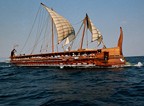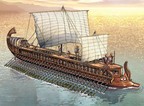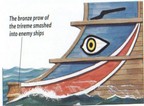The ancient Greek trireme was a successor of triakontoros and pentekontors ancient Greek ships and the ancestor of the Roman trireme and of almost all other known downstream vessels, namely the Byzantine Corvette, the corvette and the galley (late 18 century AD).
It was first built by the Corinthian shipbuilders as a successor of the Pentekontors and the bireme ancient Greek ships. Its construction was headed by the shipbuilder Ameinoklis, who solved the problem of putting three rows in the limited space available to the ancient Greek bireme (7th century BC). Pentekontors was already a ship with amazing capabilities and so he created the trireme warship, a product of flair and extraordinary intelligence, with incredible capabilities for the time. The construction is considered a milestone in the history of shipbuilding practice.
The ancient Greek trireme had a normal length of about 45 meters and a width of 6, made of very light wood, usually spruce. It had 3 tiers of oars on each side, hence the name. Its weight reached nearly 70 tons. It had 2 sails: a large square in the center and a smaller one after the bow. The host tissue could be lowered. At the bow there was a bronze ram which was its main weapon of attack which could ram and sink the sluggish enemy ships.
At the stern there was the position of the triirarchos and after that the position of the governor, then the position of the petty officer who was the commander of the oarsmen and had under his authority two pipers who were called Triirafloi. The petty officer gave orders to the address of the trireme while the triirafloi gave rhythm to the oarsmen using tubes or rattlesnakes. At the stern a large paddle was mounted on each side in order to regulate the direction of the ship. The aft ended at akrostolio, a structure resembling a large fish tail made of curved wood. Generally combined with the huge painted eyes at the bow, the trireme was particularly impressive resembling a sea monster in order to cause terror to the enemy.
The ancient Greek trireme had a crew of about 200 men on the whole: the head triirarchos, 5 non-commissioned officers and 4 petty officers, 16 lightly armed soldiers, of whom 2 archers and the remaining crew were consisted of 170 oarsmen. Of these 62 were in the lower level and were named thalamites, 54 in the middle named zygites and 54 the highest named thranites. The latter were using 7.20 meters long oars. The rest of the oarsmen were using smaller ones. Thus, the power of about 170 rowers in conjunction with the trireme’s small drought, the ship could develop high speeds (up to 8-9 knots) and the ability to move in shallow waters as well.
The ancient Greek trireme had no cabins for the crew, neither food (except water) in order not to lose his agility. For this reason, it was accompanied by other ships (ships escort). It was forbidden to be staffed by slaves. The rowers had to be free citizens and the position was considered highly prestigious.
In ancient times there were two famous triremes. These were the Paralos and the Salamis. They were considered sacred. They had crew all year long, who were in operational readiness. They served in urgent needs: money transfer, embassies etc. During wartime the General or Admiral was aboard Paralos. Salamis was used for the transfer of theories annually to Delos.
Maritime tradition museum in Piraeus, Athens has a trireme model made in proportions of 1 in 50. Recently (1987) the Navy built with the assistance of the naval architect John Coates an exact copy (1/1) of an ancient Athenian trireme and named it ” Olympia”. Olympia is formally integrated in the power of the Greek Navy. It has been used for the transfer of the Olympic flame and other tasks. An international club was founded at Oxford, named the” Union of the trireme” that mans ”Olympiad”.


